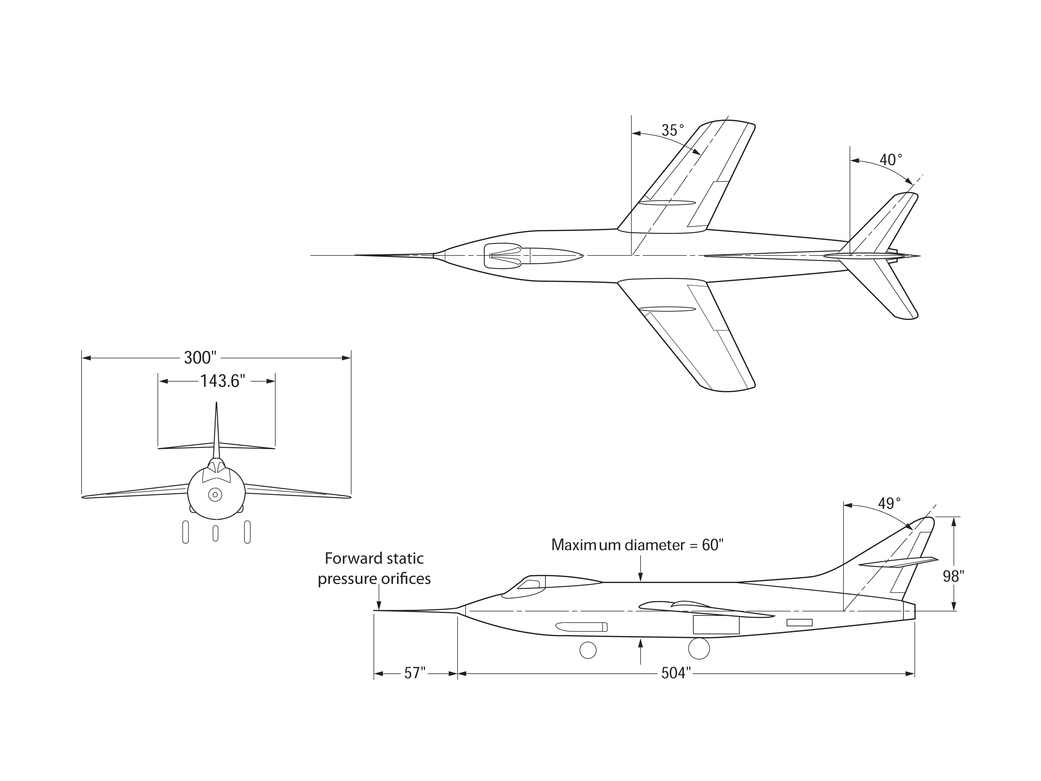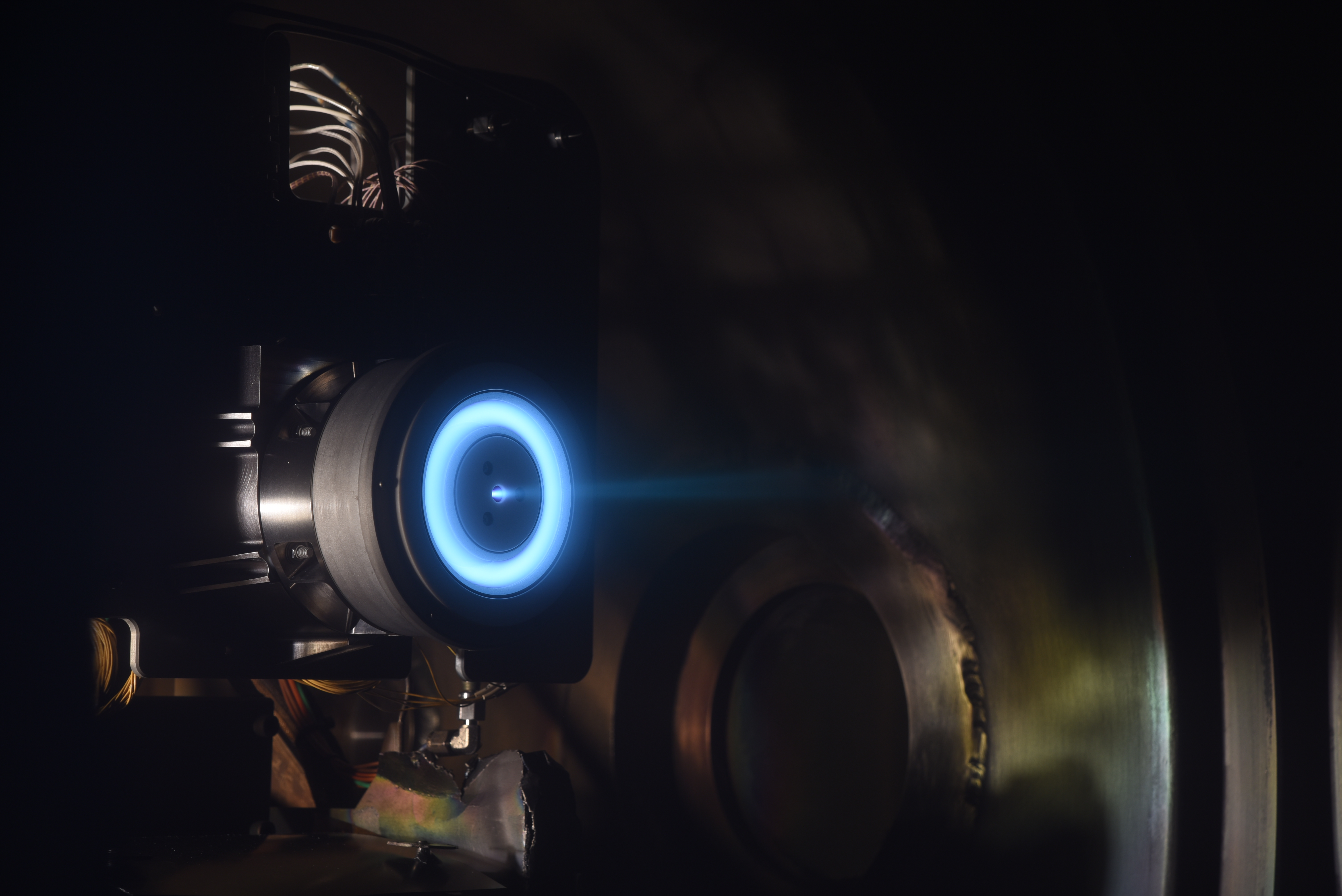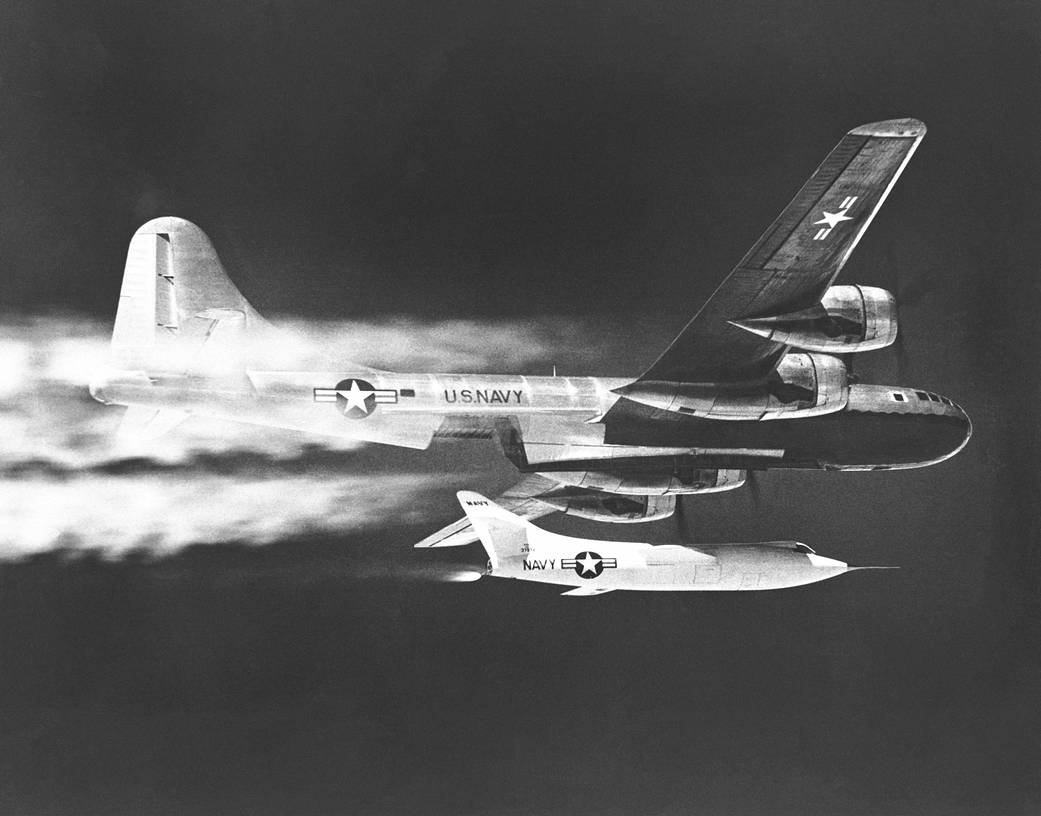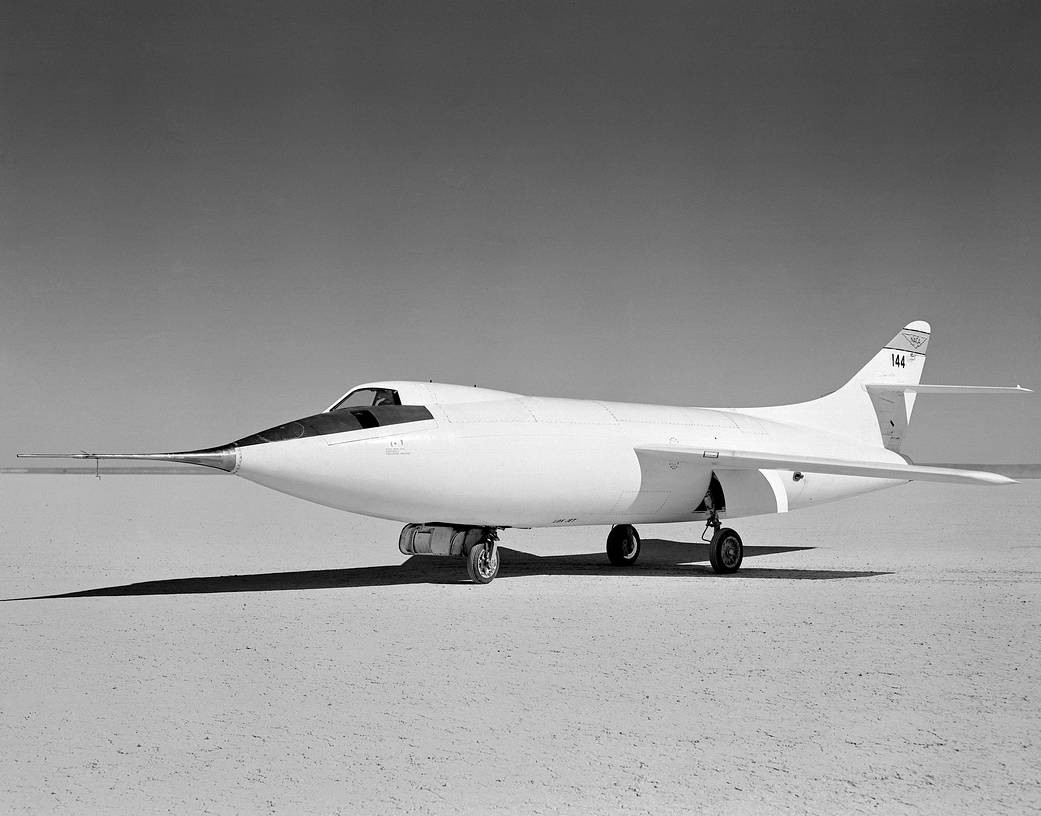The Douglas D-558-II “Skyrockets” were among the early transonic research airplanes like the X-1, X-4, X-5, and X-92A. Three of the single-seat, swept-wing aircraft flew from 1948 to 1956 in a joint program involving the National Advisory Committee for Aeronautics (NACA), with its flight research done at the NACA’s Muroc Flight Test Unit in California, redesignated in 1949 the High-Speed Flight Research Station (HSFRS); the Navy-Marine Corps; and the Douglas Aircraft Co. The HSFRS is now known as NASA’s Armstrong Flight Research Center. The Skyrocket made aviation history when it became the first airplane to fly twice the speed of sound.
The II in the aircraft’s designation referred to the fact that the Skyrocket was the phase-two version of what had originally been conceived as a three-phase program, with the phase-one aircraft having straight wings. The third phase, which never came to fruition, would have involved constructing a mock-up of a combat-type aircraft embodying the results from the testing of the phase one and two aircraft.
The D-558-II was first flown on Feb. 4, 1948, by John Martin, a Douglas test pilot. An NACA pilot, Scott Crossfield, became the first person to fly faster than twice the speed of sound when he piloted the D-558-II to its maximum speed of Mach 2.005 (1,291 mph) at 62,000 feet altitude on Nov. 20, 1953. Its peak altitude, 83,235 feet, a record in its day, was reached with Lt. Col. Marion Carl at the controls.
The three aircraft gathered a great deal of data about pitch-up and the coupling of lateral (yaw) and longitudinal (pitch) motions; wing and tail loads, lift, drag, and buffeting characteristics of swept-wing aircraft at transonic and supersonic speeds; and the effects of the rocket exhaust plume on lateral dynamic stability throughout the speed range. (Plume effects were a new experience for aircraft.) The number three aircraft also gathered information about the effects of external stores (bomb shapes, drop tanks) upon the aircraft’s behavior in the transonic region (roughly 0.7 to 1.3 times the speed of sound).
In correlation with data from other early transonic research aircraft such as the XF-92A, this information contributed to solutions to the pitch-up problem in swept-wing aircraft.
Design
The need for transonic research airplanes grew out of two conditions that existed in the early 1940s. One was the absence of accurate wind tunnel data for the speed range from roughly Mach 0.8 to 1.2. The other was the fact that fighter aircraft like the P-38 “Lightning” were approaching these speeds in dives and breaking apart from the effects of compressibility-increased density and disturbed airflow as the speed approached that of sound, creating shock waves. People in the aeronautics community – especially the NACA, the Army Air Forces (AAF), and the Navy-agreed on the need for a research airplane with enough structural strength to withstand compressibility effects in the transonic region. The AAF preferred a rocket-powered aircraft and funded the X-1, while the NACA and Navy preferred a more conservative design and pursued the D-558, with the NACA also supporting the X-1 research.

The Navy contracted with Douglas to design the airplane, and in the course of the design process, the D-558 came to be divided into two separate phases, with phase one being a straight-wing turbojet aircraft and phase two consisting of a swept-wing design with turbojet and rocket propulsion. At the NACA’s suggestion, based on the research of Robert Jones at Langley and captured German documents, Douglas and the Navy had agreed to the swept-wing design, and to provide sufficient power to propel the swept-wing airplane past Mach 1, they also agreed to add rocket propulsion.
Then, to fit both a turbojet and rocket engine in the phase two aircraft required a new fuselage. Like the D-558-I, the Skyrocket featured a horizontal stabilizer high on the vertical tail to avoid the wake from the wing. As with the X-1 and the D-558-I, the Skyrocket also featured, at NACA suggestion, a horizontal stabilizer that was thinner than the wing and movable in flight so as to avoid simultaneous shock wave effects for the wing and horizontal tail and to provide pitch (nose up or down) control when shock waves made the elevators ineffective. While Douglas was constructing the D-558-IIs, the NACA continued to furnish the contractor data it needed on aircraft performance based on tests in Langley wind tunnels and with rocket-propelled models from the Wallops Island Pilotless Aircraft Research Station.
Program History
The three airplanes flew a total of 313 times-123 by the number one aircraft (Bureau No. 37973-NACA 143), 103 by the second Skyrocket (Bureau No. 37974-NACA 144), and 87 by airplane number three (Bureau No. 37975-NACA 145). Skyrocket 143 flew all but one of its missions as part of the Douglas contractor program to test the airplane’s performance.
NACA aircraft 143 was initially powered by a Westinghouse J-34-40 turbojet engine configured only for ground take-offs, but in 1954-55 the contractor modified it to an all-rocket air-launch capability featuring an LR8-RM-6, 4-chamber Reaction Motors engine rated at 6,000 pounds of thrust at sea level (the Navy designation for the Air Force’s LR-11 used in the X-1). In this configuration, NACA research pilot John McKay flew the airplane only once for familiarization on September 17, 1956. The 123 flights of NACA 143 served to validate wind-tunnel predictions of the airplane’s performance, except for the fact that the airplane experienced less drag above Mach 0.85 than the wind tunnels had indicated.
NACA 144 also began its flight program with a turbojet powerplant. NACA pilots Robert A. Champine and John H. Griffith flew 21 times in this configuration to test airspeed calibrations and to research longitudinal and lateral stability and control. In the process, during August of 1949 they encountered pitch-up problems, which NACA engineers recognized as serious because they could produce a limiting and dangerous restriction on flight performance. Hence, they determined to make a complete investigation of the problem.
In 1950, Douglas replaced the turbojet with an LR-8 rocket engine, and its pilot, William B. Bridgeman, flew the aircraft seven times up to a speed of Mach 1.88 (1.88 times the speed of sound) and an altitude of 79,494 feet (the latter an unofficial world’s altitude record at the time, achieved on August 15, 1951). In the rocket configuration, a Navy P2B (Navy version of the B-29) launched the airplane at approximately 30,000 feet after taking off from the ground with the Skyrocket attached beneath its bomb bay. During Bridgeman’s supersonic flights, he encountered a violent rolling motion known as lateral instability that was less pronounced on the Mach 1.88 flight on August 7, 1951, than on a Mach 1.85 flight in June when he pushed over to a low angle of attack (angle of the fuselage or wing to the prevailing wind direction).
The NACA engineers studied the behavior of the aircraft before beginning their own flight research in the airplane in September 1951. Over the next couple of years, NACA pilot A. Scott Crossfield flew the airplane 20 times to gather data on longitudinal and lateral stability and control, wing and tail loads, and lift, drag, and buffeting characteristics at speeds up to Mach 1.878.
At that point, Marine Lt. Col. Marion Carl flew the airplane to a new (unofficial) altitude record of 83,235 feet on August 21, 1953, and to a maximum speed of Mach 1.728.
Following Carl’s completion of these flights for the Navy, NACA technicians at the High-Speed Flight Research Station (HSFRS) near Mojave, CA, outfitted the LR-8 engine’s cylinders with nozzle extensions to prevent the exhaust gas from affecting the rudders at supersonic speeds. This addition also increased the engine’s thrust by 6.5 percent at Mach 1.7 and 70,000 feet.
Even before Marion Carl had flown the Skyrocket, HSFRS Chief Walter C. Williams had petitioned NACA headquarters unsuccessfully to fly the aircraft to Mach 2 to garner the research data at that speed. Finally, after Crossfield had secured the agreement of the Navy’s Bureau of Aeronautics, NACA director Hugh L. Dryden relaxed the organization’s usual practice of leaving record setting to others and consented to attempting a flight to Mach 2.
In addition to adding the nozzle extensions, the NACA flight team at the HSFRS chilled the fuel (alcohol) so more could be poured into the tank and waxed the fuselage to reduce drag. With these preparations and employing a flight plan devised by project engineer Herman O. Ankenbruck to fly to approximately 72,000 feet and push over into a slight dive, Crossfield made aviation history on November 20, 1953, when he flew to Mach 2.005 (1,291 miles per hour). He became the first pilot to reach Mach 2 in this, the only flight in which the Skyrocket flew that fast.
Following this flight, Crossfield and NACA pilots Joseph A. Walker and John B. McKay flew the airplane for such purposes as to gather data on pressure distribution, structural loads, and structural heating, with the last flight in the program occurring on Dec. 20, 1956, when McKay obtained dynamic stability data and sound-pressure levels at transonic speeds and above.
Meanwhile, NACA 145 had completed 21 contractor flights by Douglas pilots Eugene F. May and Bill Bridgeman in November 1950. In this jet-and-rocket-propelled craft, Scott Crossfield and Walter Jones began the NACA’s investigation of pitch-up lasting from September 1951 well into the summer of 1953. They flew the Skyrocket with a variety of wing-fence, wing-slat, and leading-edge chord extension configurations, performing various maneuvers as well as straight-and-level flying at transonic speeds. While fences significantly aided recovery from pitch-up conditions, leading edge chord extensions did not, disproving wind-tunnel tests to the contrary. Slats (long, narrow auxiliary airfoils) in the fully open position eliminated pitch-up except in the speed range around Mach 0.8 to 0.85.
In June 1954, Crossfield began an investigation of the effects of external stores (bomb shapes and fuel tanks) upon the aircraft’s transonic behavior. McKay and Stanley Butchart completed the NACA’s investigation of this issue, with McKay flying the final mission on August 28, 1956.
Besides setting several records, the Skyrocket pilots had gathered important data and understanding about what would and would not work to provide stable, controlled flight of a swept-wing aircraft in the transonic and supersonic flight regimes. The data they gathered also helped to enable a better correlation of wind-tunnel test results with actual flight values, enhancing the abilities of designers to produce more capable aircraft for the armed services, especially those with swept wings. Moreover, data on such matters as stability and control from this and other early research airplanes aided in the design of the century series of fighter airplanes, all of which featured the movable horizontal stabilizers first employed on the X-1 and D-558 series.
The Aircraft
All three of the Skyrockets had a height of 12 feet 8 inches, a length of 42 feet, and 35-degree swept wings with a span of 25 feet.
Until configured for air launch, NACA 143 featured a Westinghouse J-34-40 turbojet engine rated at 3,000 lb of static thrust. It carried 260 gallons of aviation gasoline and weighed 10,572 lb at take-off.
NACA 144 (and NACA 143 after modification in 1955) was powered by an LR-8-RM-6 rocket engine rated at 6,000 pounds of static thrust. Its propellants were 345 gallons of liquid oxygen and 378 gallons of diluted ethyl alcohol. In its launch configuration, it weighed 15,787 lb.
NACA 145 had both an LR-8-RM-5 rocket engine rated at 6,000 pounds of static thrust and featured a Westinghouse J-34-40 turbojet engine rated at 3,000 pounds of static thrust. It carried 170 gallons of liquid oxygen, 192 gallons of diluted ethyl alcohol, and 260 gallons of aviation gasoline for a launch weight of 15,266 lb.
NACA 143 is currently in storage at the Planes of Fame Museum, Ontario, CA. The second Skyrocket, NACA 144, is in the Smithsonian Institution’s National Air and Space Museum in Washington, DC. NACA 145 is on display in front of the Antelope Valley College in Lancaster, CA.
For Further Reading
The best single source on the Skyrocket is Richard P. Hallion’s Supersonic Flight: Breaking the Sound Barrier and Beyond, The Story of the Bell X-1 and Douglas D-558 (revised edn.; London and Washington, 1997). One of the Skyrocket pilots, A. Scott Crossfield (with Clay Blair, Jr.), has told about his own flying career in Always Another Dawn: The Story of a Rocket Test Pilot (Cleveland, 1960). Another Skyrocket pilot, William Bridgeman, has related his experiences in a book written with Jacqueline Hazard, The Lonely Sky (New York, 1955).































